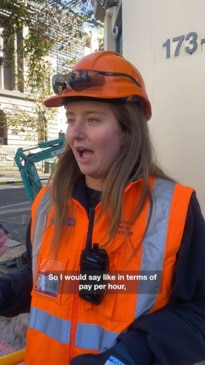Almost 500k workers needed in ‘critical’ building and construction sector
Experts have warned nearly half a million more workers are desperately needed in one sector if Australia wants to avoid increasing rates of homelessness and delays in major infrastructure projects.

Nearly half a million new building and construction workers are needed within the next two years to stem increasing rates of homelessness and keep major infrastructure projects on track.
Women and skilled migrants will be key to addressing critical worker shortages, as will microcredentials and fast-tracked qualifications to get people into jobs quickly, the Master Builders Association says.
But MBA chief executive officer Denita Wawn fears the sector will still fail to attract the 486,000 new workers required by 2026, with significant repercussions across the nation.
More than 200,000 new homes must be built each year to meet Australia’s population growth and address an alarming increase in homelessness. But Wawn says that target cannot be met under current workforce capacity.
“This is about ensuring we all have a roof over our head – that’s how critical this is,” she says.
“It’s not a ‘nice to do’, it’s a ‘need to do’, given the population growth.”

Fast-tracked training
Wawn hopes skilled migration will help to boost the construction workforce in the short term. But she says the success of the stopgap measure hinges on the speed in which migrants can have their overseas qualifications recognised in Australia.
Current wait times are up to six months, while costs involved in the skills recognition process can also be prohibitive, she says.
Longer term, Wawn says more local workers are desperately needed in the construction sector, especially women, who currently make up just 14 per cent of the workforce.
She also wants shorter, specialised training options to get people qualified and on the job sooner.
“If you become a carpenter, you learn both commercial and residential (carpentry methods) and that’s why the apprenticeship takes four years – but maybe you can split that so if you just want to do residential building then you just do two years,” Wawn says.
“That’s one of the big debates (the sector) needs to have; are there microskills and microcredentials that enable … people to get qualifications to undertake certain things, effectively becoming like a restricted licence?”
Closing the gender gap
Building-specific microcredentials are already offered in areas such as project management and contract administration, under a partnership between TAFE NSW, Western Sydney University and leading construction company CPB Contractors.
But none provide the trade skills required to work on the tools.
Nevertheless, TAFE NSW skills excellence network lead (construction and energy) Jen Perkins says they provide an opportunity for existing tradies to branch into areas outside of their original qualification, or for career changers to move into the sector in a non-trade role.
Microcredentials are also helping address gender inequality in the industry, Perkins says, with women making up 39 per cent of enrolments to date.
She says mandatory female-worker quotas for major building projects – currently under discussion in the ACT and already in place in Victoria – are also having an impact. But stereotypes around construction workers must be challenged to bring about further change.
“Those stereotypes are still alive and well – that (construction workers) have a potty mouth, they’re working on hot, dirty sites … but it’s a very different environment to what it used to be,” Perkins says.
“We certainly need to encourage all women to join the trades and we need to explain the benefits of becoming a tradie too, which is better rates of pay and a really flexible job.”

‘Sit with the big boys’
Allison Lenard worked as an employment lawyer before transitioning to the construction sector, where she is now workplace relations manager at Bechtel, the delivery partner for the new Western Sydney Airport.
Lenard says several microcredentials, including contracts administration, helped to improve her construction knowledge, allowing her to better contribute during project discussions.
“(The microcredentials) just gave me more confidence to continue in the role and not feel swamped and overwhelmed,” she says.
“Like any industry, there are lots of acronyms in construction. I can now sit at the table with the big boys … and feel as though I’m an active contributor … as opposed to sitting quietly in the meeting writing down as many words as I can to Google later.”
CPB Contractors people and culture executive general manager Sarah O’Neill says while microcredentials are not an accredited qualification, they are increasingly recognised by building companies looking to fill skills gaps.
She says as the move towards clean energy picks up pace, microcredentials will be crucial in upskilling existing construction workers to build and maintain renewable power infrastructure.
Construction workforce snapshot:
• Construction is one of the largest sectors in Australia, employing about 1.3 million people
• Nearly 10 per cent of those employed are apprentices and trainees – the highest proportion of any industry in Australia
• By 2026, a further 486,000 new building and construction workers will be needed
• About 230,000 of these new workers will be technicians and tradies, the vast majority of which will need to complete an apprenticeship.
Source: Master Builders Australia
Originally published as Almost 500k workers needed in ‘critical’ building and construction sector


